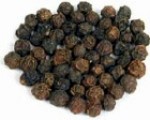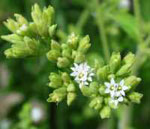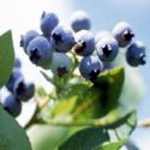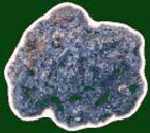 |
|||||||||||||||
|
|
Other Jiva Spices and Herbs
Black pepper
 As one of the most common spices on the table, black pepper contains important micronutrients such as copper, calcium, magnesium, and phosphorus. It was historically used as seasoning as well as medicine in traditional Indian medicine to treat various medical conditions such as acute and chronic bronchitis, leprosy, tuberculosis, and diarrhea due to its anti-inflammatory, anti-septic, analgesic, anti-diarrhetic, anti-dysenteric, and anti-microbial properties. Coming from the dried fruit of the pepper plant called peppercorn, the active ingredient of black pepper is Piperine. Piperine, the pungent component of black pepper that initials the "burning" aftertaste, enhances the bioavailability of drugs, promotes the release of epinephrine (the hormone that is important to the body's metabolism), and increases levels of circulating thyroid hormones (the hormone that controls the body processes and functions). It also has been found to be a compound that desensitizes the sensory neurons involved in pain pathways and gastrointestinal functions and this may account for the therapeutic activities of black pepper. Moreover, research studies suggest that black pepper and its active ingredient piperine are a potent protection against high-fat induced oxidative stress to cells. In other words, black pepper increases the defense mechanism of tissues and organs against cell injury and diseases by neutralizing the damage of free radicals. As one of the most common spices on the table, black pepper contains important micronutrients such as copper, calcium, magnesium, and phosphorus. It was historically used as seasoning as well as medicine in traditional Indian medicine to treat various medical conditions such as acute and chronic bronchitis, leprosy, tuberculosis, and diarrhea due to its anti-inflammatory, anti-septic, analgesic, anti-diarrhetic, anti-dysenteric, and anti-microbial properties. Coming from the dried fruit of the pepper plant called peppercorn, the active ingredient of black pepper is Piperine. Piperine, the pungent component of black pepper that initials the "burning" aftertaste, enhances the bioavailability of drugs, promotes the release of epinephrine (the hormone that is important to the body's metabolism), and increases levels of circulating thyroid hormones (the hormone that controls the body processes and functions). It also has been found to be a compound that desensitizes the sensory neurons involved in pain pathways and gastrointestinal functions and this may account for the therapeutic activities of black pepper. Moreover, research studies suggest that black pepper and its active ingredient piperine are a potent protection against high-fat induced oxidative stress to cells. In other words, black pepper increases the defense mechanism of tissues and organs against cell injury and diseases by neutralizing the damage of free radicals.Stevia  Stevioside, extracted from the herb Stevia rebaudiana, has been used as a sugar substitute in Japan and Brazil for decades with no reported significant adverse effects. Even though stevia is about 300 times sweeter than sugar, it is found to be safe for diabetics, PKU patients, and obese persons who may need to avoid sugar. Most research studies on stevia have focused on its potential therapeutic use as an anti-hypertensive agent. Both human and animal models indicate that steiva is a safe and effective compound in the treatment of hypertension, which could be explained by its ability to inhibit oxygen species formation and endothelin-1 secretion that are responsible for the production of free radicals to cause cell and tissue damage and the increase in blood pressure. Stevioside, extracted from the herb Stevia rebaudiana, has been used as a sugar substitute in Japan and Brazil for decades with no reported significant adverse effects. Even though stevia is about 300 times sweeter than sugar, it is found to be safe for diabetics, PKU patients, and obese persons who may need to avoid sugar. Most research studies on stevia have focused on its potential therapeutic use as an anti-hypertensive agent. Both human and animal models indicate that steiva is a safe and effective compound in the treatment of hypertension, which could be explained by its ability to inhibit oxygen species formation and endothelin-1 secretion that are responsible for the production of free radicals to cause cell and tissue damage and the increase in blood pressure.Cardamom  As a member of the ginger family, cardamom has been mainly used as cooking spice and medicine in India and China. It is used to alleviate indigestion, bloating, and intestinal gas. Because of its anti-bacterial, anti-microbial, and potent anti-infective effects, cardamom has also been used to treat inflammation of eyelid, teeth and gum infections, and kill bad-breath and cavity-causing bacteria. As a member of the ginger family, cardamom has been mainly used as cooking spice and medicine in India and China. It is used to alleviate indigestion, bloating, and intestinal gas. Because of its anti-bacterial, anti-microbial, and potent anti-infective effects, cardamom has also been used to treat inflammation of eyelid, teeth and gum infections, and kill bad-breath and cavity-causing bacteria.Cinnamon  Coming from the inner bark of a tree cultivated in India, China, and Sri Lanka, cinnamon has been used to treat various illnesses and diseases such as the common cold, diarrhea, digestive problems, and toothache due to its anti-bacterial and warming qualities. Multiple studies suggested that cinnamon protects against heart disease due to its anti-clotting action and its ability to lower harmful cholesterol. Being ranked as the spice that has the second highest antioxidant capacity, cinnamon prevents the formation of damaging free radicals that leads to disease and aging. It also increases insulin sensitivity and decreases glucose, which may provide a natural remedy for adult-onset diabetes. Coming from the inner bark of a tree cultivated in India, China, and Sri Lanka, cinnamon has been used to treat various illnesses and diseases such as the common cold, diarrhea, digestive problems, and toothache due to its anti-bacterial and warming qualities. Multiple studies suggested that cinnamon protects against heart disease due to its anti-clotting action and its ability to lower harmful cholesterol. Being ranked as the spice that has the second highest antioxidant capacity, cinnamon prevents the formation of damaging free radicals that leads to disease and aging. It also increases insulin sensitivity and decreases glucose, which may provide a natural remedy for adult-onset diabetes.Cocoa  Originating in South America, cocoa is the fermented fatty seed of the cocoa tree. Besides having stimulant effect, cocoa is rich in a lot of therapeutic compounds such as pyrazines, catechin, quinoxalines, pyridines, flavonol, proanthocyanidins, phenylethylamine, and methylxanthines, which are associated with the anti-tumor, anti-oxidative, anti-biotic, anti-diuretic, and anti-inflammatory properties of cocoa. Cocoa has also been shown in a variety of subject models to reduce bad cholesterol, increase good cholesterol, suppress oxidized bad cholesterol, and regulate the immune response. In other words, cocoa exerts protective effects against cardiovascular diseases, hypertension, and autoimmunity. Originating in South America, cocoa is the fermented fatty seed of the cocoa tree. Besides having stimulant effect, cocoa is rich in a lot of therapeutic compounds such as pyrazines, catechin, quinoxalines, pyridines, flavonol, proanthocyanidins, phenylethylamine, and methylxanthines, which are associated with the anti-tumor, anti-oxidative, anti-biotic, anti-diuretic, and anti-inflammatory properties of cocoa. Cocoa has also been shown in a variety of subject models to reduce bad cholesterol, increase good cholesterol, suppress oxidized bad cholesterol, and regulate the immune response. In other words, cocoa exerts protective effects against cardiovascular diseases, hypertension, and autoimmunity.Bilberry  As part of the blueberry family, bilberry is traditionally recommended to use in diabetes mellitus, bilberry gastrointestinal tract conditions, arthritis, gout, skin ailments, hemorrhoids, poor circulatory, heart problems, blood purification, and stimulate metabolic process. Bilberry has been valued for centuries as a nutritious food. In European medicine, bilberry fruit preparations are now used to enhance poor micro circulation, including eye conditions such as night-blindness and diabetic retinopathy. Numerous studies indicated that bilberry promotes improvement of visual function and regeneration of the retina. Bilberry has also been shown to speed up restoration of visual aculty following exposure to bright flashes of light. As part of the blueberry family, bilberry is traditionally recommended to use in diabetes mellitus, bilberry gastrointestinal tract conditions, arthritis, gout, skin ailments, hemorrhoids, poor circulatory, heart problems, blood purification, and stimulate metabolic process. Bilberry has been valued for centuries as a nutritious food. In European medicine, bilberry fruit preparations are now used to enhance poor micro circulation, including eye conditions such as night-blindness and diabetic retinopathy. Numerous studies indicated that bilberry promotes improvement of visual function and regeneration of the retina. Bilberry has also been shown to speed up restoration of visual aculty following exposure to bright flashes of light.Shilajit  In Sanskrit, shilajit/shilajeet means "conqueror of mountains and destroyer of weakness". It contains more than 85 minerals, and has been used as a rejuvenator and an adaptogen for thousands of years due to its potent anti-inflammatory and anti-oxidative properties. Shilajit is a natural concentrate of plants of the Himalayas regions, and it is the fossilized form of the plants that had absorbed nutrients from the soil and then died out. This repeated process of thousands of years and the distinct biosphere of the Himalayas created and bestowed medicinal qualities to shilajit, and its healing properties are well-known to the local people for long. In modern research, shilajit has been shown to attenuate cerebral functional deficits and enhance cognitive and memory. In Sanskrit, shilajit/shilajeet means "conqueror of mountains and destroyer of weakness". It contains more than 85 minerals, and has been used as a rejuvenator and an adaptogen for thousands of years due to its potent anti-inflammatory and anti-oxidative properties. Shilajit is a natural concentrate of plants of the Himalayas regions, and it is the fossilized form of the plants that had absorbed nutrients from the soil and then died out. This repeated process of thousands of years and the distinct biosphere of the Himalayas created and bestowed medicinal qualities to shilajit, and its healing properties are well-known to the local people for long. In modern research, shilajit has been shown to attenuate cerebral functional deficits and enhance cognitive and memory. |